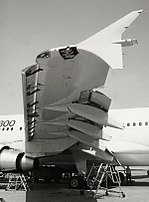The Nakajima Ki-43 Hayabusa (隼, "Peregrine falcon"), formal Japanese designation Army Type 1 Fighter (一式戦闘機, Ichi-shiki sentōki) is a single-engine land-based...
37 KB (4,215 words) - 07:05, 25 September 2024
larger in diameter than the 1,144 mm Nakajima Sakae (used in the Mitsubishi A6M "Zero" and Nakajima Ki-43 "Hayabusa"). However, the Sakae was only 27.8L...
21 KB (2,610 words) - 02:34, 8 September 2024
Prefecture in Japan Nakajima Ki-43 Hayabusa, World War II fighter airplane Hayabusa-class torpedo boat of the Imperial Japanese Navy Hayabusa-class patrol boat...
2 KB (229 words) - 00:03, 14 June 2024
The Nakajima Ki-84 Hayate (キ84 疾風, lit. "Gale") is a single-seat fighter flown by the Imperial Japanese Army Air Service in the last two years of World...
22 KB (2,583 words) - 00:38, 2 October 2024
Ki-27 - Type 97 Fighter (九七式戦闘機) - late 1936 Army monoplane fighter Ki-37 - 1937 fighter (project only) Ki-43 - Type 1 Fighter (一式単座戦闘機) or Hayabusa (隼...
14 KB (1,423 words) - 07:24, 23 August 2024
The Nakajima Ki-27 (九七式戦闘機, Kyūnana-shiki sentōki, Type 97 Fighter) was the main fighter aircraft used by the Imperial Japanese Army Air Service up until...
20 KB (2,492 words) - 09:48, 3 October 2024
The Nakajima Ki-116 was a late-World War II aircraft developed for the Imperial Japanese Army Air Force. It was essentially a Ki-84 Hayate with the Nakajima...
5 KB (578 words) - 01:19, 8 September 2024
On 25 December, the JAAF returned, reinforced by Ki-21s of 12th Sentai and Nakajima Ki-43 Hayabusas (Oscars) of the 64th Sentai (Colonel Tateo Katō's...
63 KB (8,192 words) - 07:43, 27 May 2024
The Nakajima Ki-49 Donryu (呑龍, "Storm Dragon") was a twin-engine Japanese World War II heavy bomber. It was designed to carry out daylight bombing missions...
10 KB (1,283 words) - 21:18, 6 October 2024
The Nakajima Ki-201 Karyū (中島 キ201 火龍, "Fire Dragon") was a Japanese jet fighter aircraft-attack aircraft project designed during the final stages of...
6 KB (501 words) - 00:45, 8 September 2024
roughly comparable with fighters like Hawker Hurricane or the Nakajima Ki-43 Hayabusa. Rate of climb was even more improved: 16,400 ft (5,000 m) in 6...
14 KB (1,582 words) - 07:04, 26 October 2024
Lockheed P2V-7 Neptune Lockheed PV-2D Harpoon Martin AM-1 Mauler Nakajima Ki-43 Hayabusa – reproduction North American TB-25N Mitchell North American T-6G...
9 KB (729 words) - 04:39, 10 October 2024
Mitsubishi A6M Zero at the time, but later determined to be a Nakajima Ki-43 Hayabusa—while flown by Pilot Officer John S. "Jack" Archer. Following the...
44 KB (5,555 words) - 00:17, 10 September 2024
his unit returned to Japan to exchange their Nakajima Ki-27 "Nates" for more advanced Ki-43 "Hayabusas" (allied code name "Oscar"). The 50th Air Squadron...
11 KB (849 words) - 03:35, 11 December 2023
1985, exhibits include four planes: a Nakajima Ki-43 Hayabusa, a 1943 Kawasaki Ki-61 Hien, a 1944 Nakajima Ki-84 Hayate, and a Mitsubishi Zero recovered...
9 KB (916 words) - 00:52, 27 July 2024
Berkshire, UK: Profile Publications Ltd., 1971. Stanaway, John. Nakajima Ki.43 "Hayabusa": Allied Code Name "Oscar". Bennington, Vermont: Merriam Press...
73 KB (9,634 words) - 02:29, 26 October 2024
The Nakajima Ki-115 Tsurugi (剣, "sabre") is a one-man kamikaze aircraft that was developed by the Imperial Japanese Army Air Force during the closing...
10 KB (1,064 words) - 01:19, 8 September 2024
Rufe 1941 327 IJN Nakajima J1N1-S Gekko Irving 1941 479 IJN Nakajima Ki-27 Army Type 97 Fighter Nate 1937 3368 IJA Nakajima Ki-43 Hayabusa Army Type 1 Fighter...
11 KB (78 words) - 03:00, 7 May 2024
Sentai, based at Guangzhou, China, and equipped with the latest Nakajima Ki-43 Hayabusa fighters. His unit participated in the early stages of the war...
8 KB (983 words) - 02:02, 22 May 2024
The Nakajima Ki-34 was a Japanese light transport of World War II. It was a twin-engine, low-wing monoplane; the undercarriage was of tailwheel type with...
8 KB (713 words) - 02:44, 12 September 2024
was involved in designing aircraft at the Nakajima Aircraft Company and designed the Nakajima Ki-43 Hayabusa ("peregrine falcon"; Allied reporting name...
6 KB (408 words) - 18:52, 17 October 2024
the Nakajima Ki-43 Hayabusa ("Oscar") – the main fighter used by the Imperial Japanese Army Air Force during the war – in Papua New Guinea. The Ki-43s...
13 KB (1,368 words) - 01:13, 25 February 2024
Navy Manchukuo Imperial Guard Jowett 2004, pp. 90–92. cocinilla. "Nakajima Ki-43 Hayabusa [Cazabombardero]". La Segunda Guerra (in Spanish). Retrieved 2020-03-27...
9 KB (726 words) - 04:42, 28 October 2024
Bell P-63 Kingcobra (redirect from Bell 43)
Lejtenant I. F. Miroshnichenko from 17th IAP/190 IAD, shot down a Nakajima Ki-43 Hayabusa IJAAS fighter off the coast of North Korea. Sufficient aircraft...
40 KB (5,483 words) - 15:44, 7 October 2024
built by them from scratch. The museum subsequently restored a Nakajima Ki-43 Hayabusa/Oscar fighter. of the Imperial Japanese Army Air Service The museum...
8 KB (615 words) - 18:49, 6 May 2023
Type 24 "Rata" Polikarpov U-2/Po-2 Ilyushin II-2M3 Shturmovik Nakajima Ki-43 Hayabusa (Oscar) Mitsubishi A6M3-22 Reisen (Zero or Zeke) Fiesler Fi 103...
14 KB (1,437 words) - 04:43, 2 August 2024
ISBN 978-0-521-84140-5/ISBN 0-521-84140-2 Windrow, Martin C. and René J. Francillon. The Nakajima Ki-43 Hayabusa. Leatherhead, Surrey, UK: Profile Publications, 1965....
32 KB (4,043 words) - 00:53, 18 August 2024
Kawasaki staged a fly-off between two Ki-61 prototypes and the Nakajima Ki-43-I, a pre-production Nakajima Ki-44-I, a defector-flown Lavochkin-Gorbunov-Goudkov...
48 KB (5,032 words) - 01:19, 8 September 2024
The prefix "Ki" in this list is an abbreviation of "Kitai", meaning "airframe", and was used only by the Imperial Japanese Army Air Force. "Ki" should be...
30 KB (162 words) - 10:59, 26 September 2024
Yohei Hinoki and his wingman score the first aerial victory by the Nakajima Ki-43 Hayabusa ("peregrine falcon"; Allied reporting name "Oscar") fighter, forcing...
87 KB (11,701 words) - 10:54, 31 October 2024
























